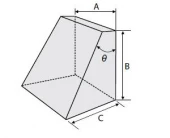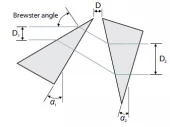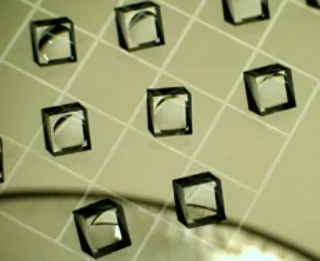Description
Anamorphic Prisms are a pair of prisms designed to alter the dimension of a beam in one axis, similar to the effect of a cylindrical lens. These prisms offer the ability to expand or contract the beam in one direction without affecting the other direction.
By adjusting the angles among the incident beam and the two prisms, the shape of the beam can be changed, allowing easy conversion of an elliptical beam into a circular beam.
Anamorphic prisms are cost-effective alternatives to cylindrical lenses of comparable quality and can be used in various optical setups for beam shaping and size adjustment.
14AP-1-1 Anamorphic Prisms
Specifications
| Material: | N-SF11 |
|---|---|
| Dimension (A): | 12 mm |
| Dimension (B): | 12 mm |
| Dimension (C): | 8.5 mm |
| AR Coating: | MgF2 Single Layer |
| Dimension Tolerances: | +0.0, -0.2 mm |
| Surface Flatness <λ/8 @ 632.8 Nm: | <λ/8 @ 632.8 nm |
| Surface Quality: | 60-40 scratch & dig |
| Theta Angle: | 29°27' ± 3 |
| Clear Aperture: | > 85% in central circular dimension |
Features
- Compact package design using cylindrical optics
- Adjustability to compensate for variations from one light source to another
- Cost-effective compared to cylindrical lenses of similar quality
- Easy conversion of elliptical beams into circular beams
- High precision dimension tolerances for accurate beam manipulation
- High surface flatness for minimal optical aberrations
- Coated with MgF2 single layer on the perpendicular surface
- Mount available upon request for convenient integration into optical systems
Applications
- Beam shaping in laser and optical systems
- Transforming elliptical beams into circular beams
- Optical setups requiring precise beam expansion or contraction
- Beam homogenization and size adjustment in various imaging applications
- Research and development in photonics, laser technology, and imaging systems
Frequently Asked Questions
What are anamorphic prisms used for?
Anamorphic prisms are used to change the dimension of a beam in one axis, the effect being analogous to that of a cylindrical lens. These two prisms can expand or contract the beam in one direction without any changes in the other direction.
How can the shape of the beam be changed using anamorphic prisms?
By adjusting the angles among the incident beam and two prisms, the shape of the beam can be changed. It is very easy to turn elliptical beam into circular beam.
What are the benefits of using a system using a pair of anamorphic prisms?
If beam shaping is required, a system using a pair of anamorphic prisms has several significant benefits. A pair of prisms can be designed into a much more compact package than a telescope using cylindrical optics. The ability of adjusting the position of the prisms allows the user to compensate for variations from one light source to another. The prisms are more cost effective than cylindrical lenses of comparable quality.
What is a dove prism used for?
Dove prism is a type of reflective prism which is used to invert an image. Dove prisms are shaped from a truncated right-angle prism. A beam of light entering one of the sloped faces of the prism undergoes total internal reflection from the inside of the longest (bottom) face and emerges from the opposite sloped face. Images passing through the prism are flipped, and because only one reflection takes place, the image’s handedness is changed to the opposite sense.
What are the standard specifications of 14DOP Dove Prisms?
The standard specifications of 14DOP Dove Prisms are Material: BK7, UVFS, Dimension Tolerances: +0.0, −0.2 mm, Angle Tolerance: <3 arcmin, Surface Flatness: <λ/2 @ 632.8 nm, Surface Quality: 60-40 scratch & dig, Dimension Tolerance: ±0.2 mm, Clear Aperture: >80%.
Similar Products
Thank You!
Your inquiry has been received.
Create an account by adding a password
Why create an account?
- Auto-complete inquiry forms
- View and manage all your past messages
- Save products to your favorites
- Close your account anytime — no hassle



